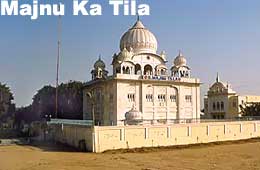| India Profile » Monuments and Temples in India » Majnu-ka-Tila, Delhi | ||
| ||
|
A fakir lived on the banks of river Yamuna during the reign of Sultan Sikander Lodhi. He used to carry people across the river in his boat free of charge. He used to spend most of his time in prayers and meditation and yearned for the glimpse of the God. He was so much lost in his own thoughts often fasted. As a result of which he became thin and people started calling him Majnu after the Persian lover whose name became symbolic of intense love in mysticism in the Sufi literature. One day, the fakir met Guru Nanak who blessed him and after that he achieved supreme enlightenment. He became the disciple of the Guru. His hermitage on the banks of the river Yamuna thereafter came to be known as Majnu-Ka-Tila. Many yogis, sufis and fakirs came to hold spiritual discourses with Guru Nanak at this place. Most prominent among them was the Sajadanahin of famous Saint Nizamuddin Auliya. He was deeply influenced by the teaching of Guru Nanak. When Guru Har Gobind, the Sixth Guru, was invited by Emperor Jahangir he stayed at Majnu-Ka-Tila. Guru Har Gobind starter preaching his name and many people thronged to him to listen to his spiritual discourses. The Emperor became suspicious and imprisoned him in the Fort of Gwalior. After his release from the prison, Guru Har Gobind again stayed at Majnu-Ka-Tila on his way back to Punjab. Thus, the shrine gained great importance and a gurudwara was constructed. There is a well in the gurudwara compound. Sardar Baghel Singh who came to Delhi in 1783 AD encamped at Majnu-Ka-Tila. He raised a small structure at this sacred place in the memory of the Sikh Gurus. The marble gurudwara was constructed by Maharaja Ranjit Singh, parts of which can be seen even today. He also endowed it with a Jagir, the income from which was used for the maintenance of the gurudwara. The present building constructed in 1950. |
||
 |
